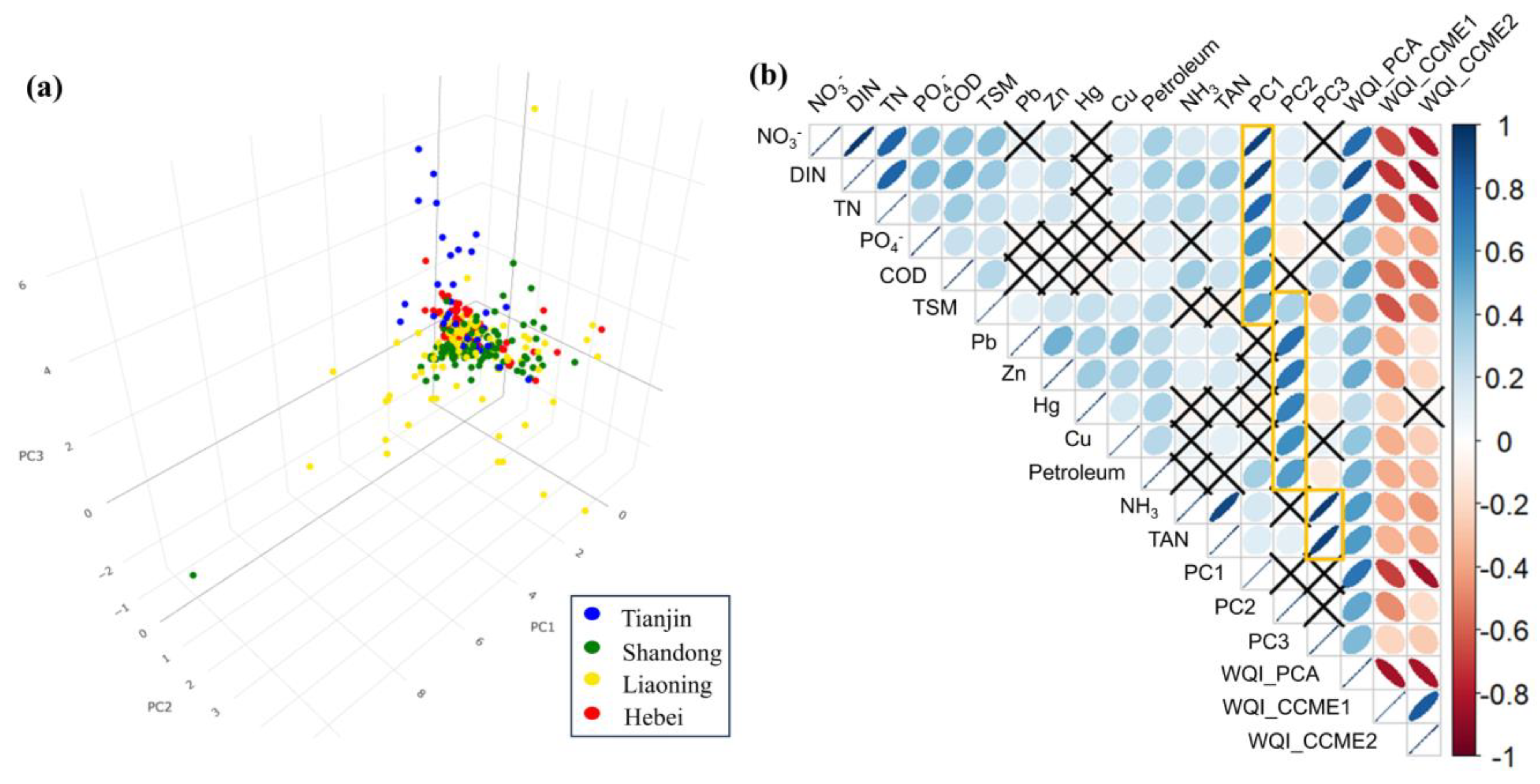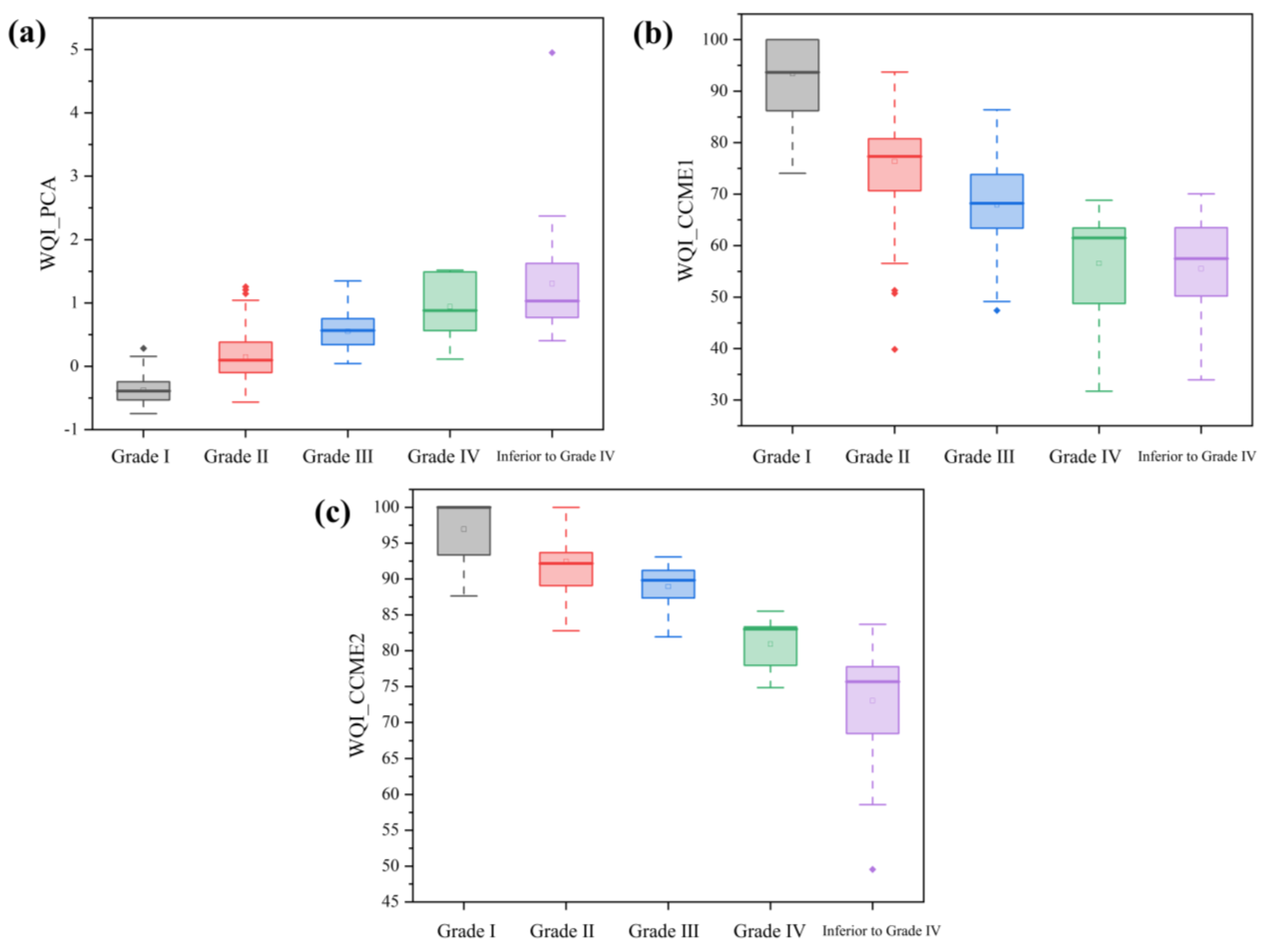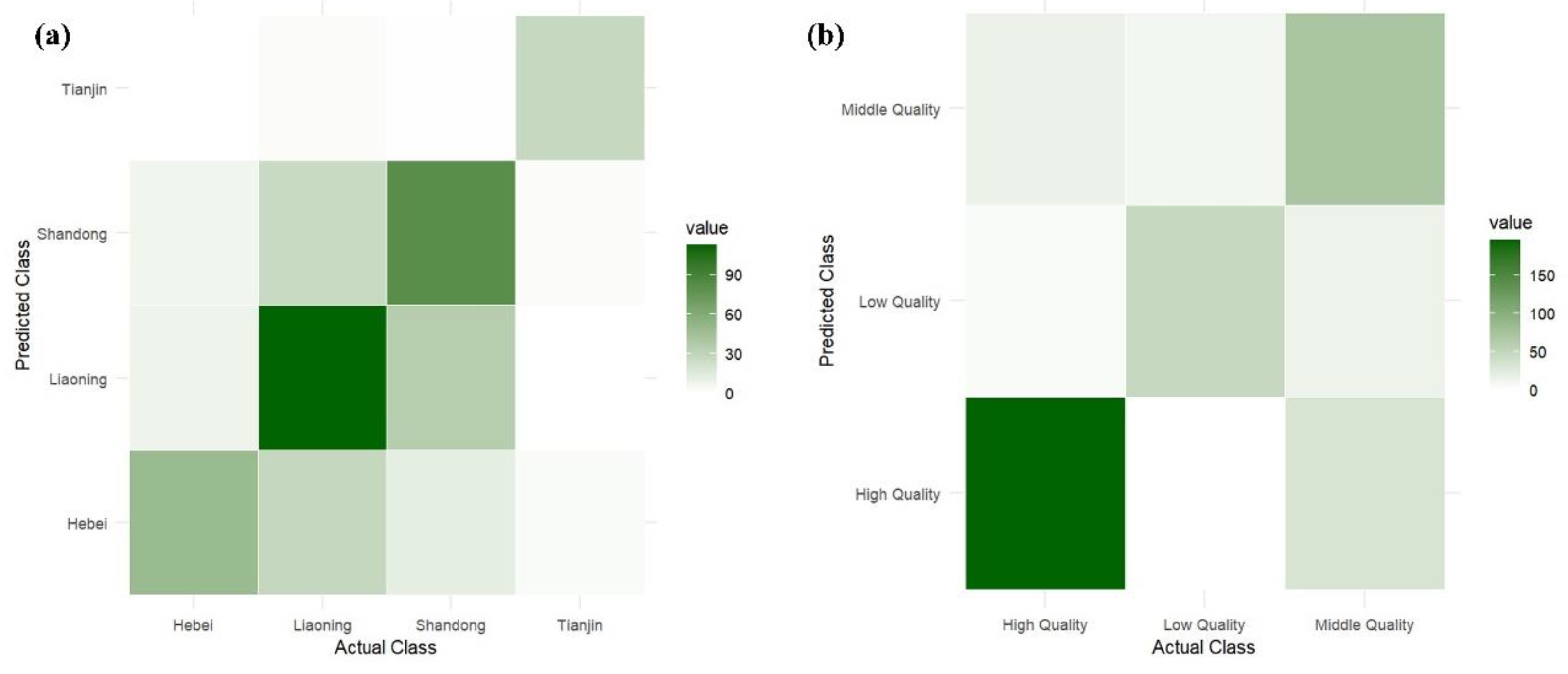Towards Sustainable Water Quality Management in the Bohai Sea: A Multivariate Statistical Analysis of Nearshore Pollution
Abstract
1. Introduction
2. Materials and Methods
2.1. Sampling Area
2.2. Water Quality Variables and Chemical Analysis
2.3. Analysis Method
2.3.1. Principal Component Analysis
2.3.2. Water Quality Index
2.3.3. Cluster Analysis
2.3.4. Discriminant Analysis
2.3.5. Statistical and Spatial Analysis
3. Results and Discussion
3.1. PCA of Water Quality in the Nearshore Bohai Sea Area
3.2. Cluster Analysis Results of the Three WQI Methods
3.3. Discriminant Analysis for Validation of WQI_PCA Classification
3.4. Nonlinear Regression Analysis of GDP and WQI Using the Environmental Kuznets Curve (EKC) Model
3.5. Management Implications
4. Conclusions
Author Contributions
Funding
Institutional Review Board Statement
Informed Consent Statement
Data Availability Statement
Acknowledgments
Conflicts of Interest
References
- Meng, W.; Hu, B.; He, M.; Liu, B.; Mo, X.; Li, H.; Wang, Z.; Zhang, Y. Temporal-spatial variations and driving factors analysis of coastal reclamation in China. Estuar. Coast. Shelf Sci. 2017, 191, 39–49. [Google Scholar] [CrossRef]
- Gao, X.; Chen, C.T. Heavy metal pollution status in surface sediments of the coastal Bohai Bay. Water Res. 2012, 46, 1901–1911. [Google Scholar] [CrossRef]
- Wang, Y.; Li, K.; Li, Y.; Lu, S.; Wang, B.; Wang, X. Assessing the total maximum allocated load of jurisdiction petroleum pollutants in the Bohai Sea. Ocean Coast. Manag. 2018, 151, 150–164. [Google Scholar] [CrossRef]
- Zhou, D.; Yu, M.; Yu, J.; Li, Y.; Guan, B.; Wang, X.; Wang, Z.; Lv, Z.; Qu, F.; Yang, J. Impacts of inland pollution input on coastal water quality of the Bohai Sea. Sci. Total Environ. 2021, 765, 142691. [Google Scholar] [CrossRef]
- Yu, J.; Zhou, D.; Yu, M.; Yang, J.; Li, Y.; Guan, B.; Wang, X.; Zhan, C.; Wang, Z.; Qu, F. Environmental threats induced heavy ecological burdens on the coastal zone of the Bohai Sea, China. Sci. Total Environ. 2021, 765, 142694. [Google Scholar] [CrossRef] [PubMed]
- Ministry of Ecology and Environment, PRC. Action Plan for the Uphill Battles for Integrated Bohai SEA Management. Available online: https://english.mee.gov.cn/News_service/news_release/201812/t20181224_685801.shtml (accessed on 1 October 2024).
- Chen, Y.; Ma, Y.; Wang, Y.; Sun, Z.; Han, Y. Impact of China’s marine governance policies on the marine ecological environment—A case study of the Bohai rim. Ocean Coast. Manag. 2023, 246, 106913. [Google Scholar] [CrossRef]
- Haihe River Water Conservancy Commission. Haihe River Water Resources Bulletin (Year 2021). Available online: http://www.hwcc.gov.cn/hwcc/static/szygb/gongbao2021/index.html (accessed on 1 October 2024).
- Water Resources Department of Shandong Province. Shandong Province Water Resources Bulletin (Year 2022). Available online: http://wr.shandong.gov.cn/zwgk_319/fdzdgknr/tjsj/szygb/202208/P020220905624327687827.pdf (accessed on 1 October 2024).
- Chen, Y.; Zhai, F.; Gu, Y.; Cao, J.; Liu, C.; Liu, X.; Liu, Z.; Li, P. Seasonal variability in dissolved oxygen in the Bohai Sea, China. J. Oceanol. Limnol. 2021, 40, 78–92. [Google Scholar] [CrossRef]
- Liang, W.; Wang, Y.; Mu, J.; Wu, N.; Wang, J.; Liu, S. Nutrient changes in the Bohai Sea over the past two decades. Sci. Total Environ. 2023, 903, 166696. [Google Scholar] [CrossRef] [PubMed]
- Gao, X.; Zhou, F.; Chen, C.T. Pollution status of the Bohai Sea: An overview of the environmental quality assessment related trace metals. Environ. Int. 2014, 62, 12–30. [Google Scholar] [CrossRef] [PubMed]
- Liu, S.; Lou, S.; Kuang, C.; Huang, W.; Chen, W.; Zhang, J.; Zhong, G. Water quality assessment by pollution-index method in the coastal waters of Hebei Province in western Bohai Sea, China. Mar. Pollut. Bull. 2011, 62, 2220–2229. [Google Scholar] [CrossRef]
- Wu, G.; Li, J.; Luo, W. Spatial distribution, source apportionment, and assessment of marine water quality parameters in the Bohai Sea, China. Mar. Pollut. Bull. 2023, 195, 115526. [Google Scholar] [CrossRef] [PubMed]
- Xie, L.; Xu, H.; Xin, M.; Wang, B.; Tu, J.; Wei, Q.; Sun, X. Regime shifts in trophic status and regional nutrient criteria for the Bohai Bay, China. Mar. Pollut. Bull. 2021, 170, 112674. [Google Scholar] [CrossRef] [PubMed]
- Yang, Y.; Liang, S.; Li, K.; Li, Y.; Li, J.; Wang, X. Integrated water-quality management indicators from river to sea: A case study of the Bohai Sea, China. Mar. Pollut. Bull. 2022, 185, 114320. [Google Scholar] [CrossRef]
- Dong, Z.; Kuang, C.; Gu, J.; Zou, Q.; Zhang, J.; Liu, H.; Zhu, L. Total maximum allocated load of chemical oxygen demand near Qinhuangdao in Bohai Sea: Model and Field Observations. Water 2020, 12, 1141. [Google Scholar] [CrossRef]
- Li, Z.; Tian, C.; Sheng, Y. Fluxes of chemical oxygen demand and nutrients in coastal rivers and their influence on water quality evolution in the Bohai Sea. Reg. Stud. Mar. Sci. 2022, 52, 102322. [Google Scholar] [CrossRef]
- Wang, Y.; Shi, J.; Tian, X.; Peng, H.; Li, X.; Song, D.; Mao, X.; Lv, X. Study on load allocation of land-based total nitrogen in the Bohai Sea. Sci. Total. Environ. 2024, 923, 171470. [Google Scholar] [CrossRef]
- Wang, Z.; Luo, P.; Zha, X.; Xu, C.; Kang, S.; Zhou, M.; Nover, D.; Wang, Y. Overview assessment of risk evaluation and treatment technologies for heavy metal pollution of water and soil. J. Clean. Prod. 2022, 379, 134043. [Google Scholar] [CrossRef]
- Ubuoh, E.A.; Nwogu, F.U.; Ofoegbu, C.C.; Chikezie, P.C. Environmental pollution loads on surface water chemistry and potentially ecological risks of inland aquatic ecosystem in South-Eastern State, Nigeria. Environ. Syst. Res. 2023, 12, 22. [Google Scholar] [CrossRef]
- Wu, G.; Ye, D.; Luo, W. Water quality analysis and source apportionment in estuaries along the coast of the Bohai Sea, North China. J. Oceanol. Limnol. 2024, 1–17. [Google Scholar] [CrossRef]
- Arıman, S.; Soydan-Oksal, N.G.; Beden, N.; Ahmadzai, H. Assessment of groundwater quality through hydrochemistry using principal components analysis (PCA) and water quality index (WQI) in Kızılırmak delta, Turkey. Water 2024, 16, 1570. [Google Scholar] [CrossRef]
- Ministry of Ecology and Environment, PRC. Technical Specification for Offshore Environmental Monitoring: Part 3—Offshore Seawater Quality Monitoring; Ministry of Ecology and Environment: Beijing, China, 2020. [Google Scholar]
- Ma, Z.; Li, H.; Ye, Z.; Wen, J.; Hu, Y.; Liu, Y. Application of modified water quality index (WQI) in the assessment of coastal water quality in main aquaculture areas of Dalian, China. Mar. Pollut. Bull. 2020, 157, 111285. [Google Scholar] [CrossRef] [PubMed]
- Uddin, M.G.; Nash, S.; Olbert, A.I. A review of water quality index models and their use for assessing surface water quality. Ecol. Indic. 2021, 122, 107218. [Google Scholar] [CrossRef]
- Canadian Council of Ministers of the Environment. Guidance Manual for Optimizing Water Quality Monitoring Program Design. Available online: https://ccme.ca/en/res/guidancemanualforoptimizingwaterqualitymonitoringprogramdesign_1.0_e.pdf (accessed on 1 October 2024).
- Canadian Council of Ministers of the Environment. Canadian Water Quality Guideline for the Protection of Aquatic Life. Available online: https://ccme.ca/en/res/wqimanualen.pdf (accessed on 1 October 2024).
- Ministry of Ecology and Environment, PRC. Seawater Quality Standard of China (GB 3097-1997). Available online: https://english.mee.gov.cn/Resources/standards/water_environment/quality_standard/200710/W020061027511546974673.pdf (accessed on 1 October 2024).
- Ministry of Ecology and Environment, PRC. Environmental Quality Standard for Surface Water (GB 3838-2002). Available online: https://english.mee.gov.cn/standards_reports/standards/water_environment/quality_standard/200710/t20071024_111792.htm (accessed on 1 October 2024).
- Hajigholizadeh, M.; Melesse, A.M. Assortment and spatiotemporal analysis of surface water quality using cluster and discriminant analyses. Catena 2017, 151, 247–258. [Google Scholar] [CrossRef]
- Singh, K.P.; Malik, A.; Mohan, D.; Sinha, S. Multivariate statistical techniques for the evaluation of spatial and temporal variations in water quality of Gomti River (India)—A case study. Water Res. 2004, 38, 3980–3992. [Google Scholar] [CrossRef] [PubMed]
- Mammeri, A.; Tiri, A.; Belkhiri, L.; Salhi, H.; Brella, D.; Lakouas, E.; Tahraoui, H.; Amrane, A.; Mouni, L. Assessment of surface water quality using water quality index and discriminant analysis method. Water 2023, 15, 680. [Google Scholar] [CrossRef]
- Wang, B.; Liu, L.; Huang, G. Retrospective and prospective analysis of water use and point source pollution from an economic perspective-a case study of Urumqi, China. Environ. Sci. Pollut. Res. 2017, 24, 26016–26028. [Google Scholar] [CrossRef] [PubMed]
- Wang, Z.; Bu, C.; Li, H.; Wei, W. Seawater environmental Kuznets curve: Evidence from seawater quality in China’s coastal waters. J. Clean. Prod. 2019, 219, 925–935. [Google Scholar] [CrossRef]
- Lyu, L.; Bagchi, M.; Markoglou, N.; An, C.; Peng, H.; Bi, H.; Yang, X.; Sun, H. Towards environmentally sustainable management: A review on the generation, degradation, and recycling of polypropylene face mask waste. J. Hazard. Mater. 2024, 461, 132566. [Google Scholar] [CrossRef] [PubMed]






| Variables | Grade I Limitation | Grade III Limitation |
|---|---|---|
| Unit (mg/L) | ||
| COD | 2 | 4 |
| PO43− | 0.015 | 0.03 |
| NO3−-N | 0.2 | 0.4 |
| TN | 0.2 | 0.2 |
| DIN | 0.2 | 0.4 |
| TSM | 10 | 100 |
| Petroleum | 0.05 | 0.3 |
| Pb | 0.001 | 0.01 |
| Zn | 0.02 | 0.1 |
| Cu | 0.005 | 0.01 |
| Hg | 0.00005 | 0.0002 |
| NH3 | 0.02 | 0.02 |
| TAN | 0.2 | 0.4 |
| Component | Total | % of Variance | Cumulative % |
|---|---|---|---|
| PC1 | 3.436 | 26.428 | 26.428 |
| PC2 | 2.418 | 18.602 | 45.030 |
| PC3 | 2.079 | 15.989 | 61.020 |
| Indicator | PC1 | PC2 | PC3 |
|---|---|---|---|
| NO3−-N | 0.939 | ||
| DIN | 0.918 | ||
| TN | 0.792 | ||
| PO4 | 0.575 | ||
| COD | 0.561 | ||
| TSM | 0.512 | 0.316 | |
| Pb | 0.756 | ||
| Zn | 0.729 | ||
| Hg | 0.671 | ||
| Cu | 0.612 | ||
| Petroleum | 0.336 | 0.558 | |
| NH3 | 0.944 | ||
| TAN | 0.928 |
| Actual/Predicted | High Quality | Low Quality | Middle Quality |
|---|---|---|---|
| High Quality | 195 | 5 | 16 |
| Low Quality | 0 | 48 | 10 |
| Middle Quality | 33 | 15 | 71 |
| Actual/Predicted | Hebei | Liaoning | Shandong | Tianjin |
|---|---|---|---|---|
| Hebei | 49 | 8 | 7 | 0 |
| Liaoning | 28 | 112 | 26 | 2 |
| Shandong | 12 | 35 | 81 | 1 |
| Tianjin | 3 | 0 | 2 | 27 |
| Predictor | GDP/per Capita | Total GDP | ||
|---|---|---|---|---|
| 2nd-Order | 3rd-Order | 2nd-Order | 3rd-Order | |
| Intercept (β0) | −80.794 | −694.561 | 1.118 | −253.957 ** |
| Linear (β1) | 14.408 | 179.938 | −0.161 | 94.928 ** |
| Quadratic (β2) | −0.640 | −15.506 | 0.005 | −11.727 ** |
| Cubic (β3) | NA | 0.445 | NA | 0.479 ** |
| R2 | 0.110 | 0.120 | 0.033 | 0.596 |
Disclaimer/Publisher’s Note: The statements, opinions and data contained in all publications are solely those of the individual author(s) and contributor(s) and not of MDPI and/or the editor(s). MDPI and/or the editor(s) disclaim responsibility for any injury to people or property resulting from any ideas, methods, instructions or products referred to in the content. |
© 2024 by the authors. Licensee MDPI, Basel, Switzerland. This article is an open access article distributed under the terms and conditions of the Creative Commons Attribution (CC BY) license (https://creativecommons.org/licenses/by/4.0/).
Share and Cite
Gao, W.; Wang, H.; Zhang, P.; An, C. Towards Sustainable Water Quality Management in the Bohai Sea: A Multivariate Statistical Analysis of Nearshore Pollution. Sustainability 2024, 16, 11187. https://doi.org/10.3390/su162411187
Gao W, Wang H, Zhang P, An C. Towards Sustainable Water Quality Management in the Bohai Sea: A Multivariate Statistical Analysis of Nearshore Pollution. Sustainability. 2024; 16(24):11187. https://doi.org/10.3390/su162411187
Chicago/Turabian StyleGao, Wei, Hongcui Wang, Pengyu Zhang, and Chunjiang An. 2024. "Towards Sustainable Water Quality Management in the Bohai Sea: A Multivariate Statistical Analysis of Nearshore Pollution" Sustainability 16, no. 24: 11187. https://doi.org/10.3390/su162411187
APA StyleGao, W., Wang, H., Zhang, P., & An, C. (2024). Towards Sustainable Water Quality Management in the Bohai Sea: A Multivariate Statistical Analysis of Nearshore Pollution. Sustainability, 16(24), 11187. https://doi.org/10.3390/su162411187







